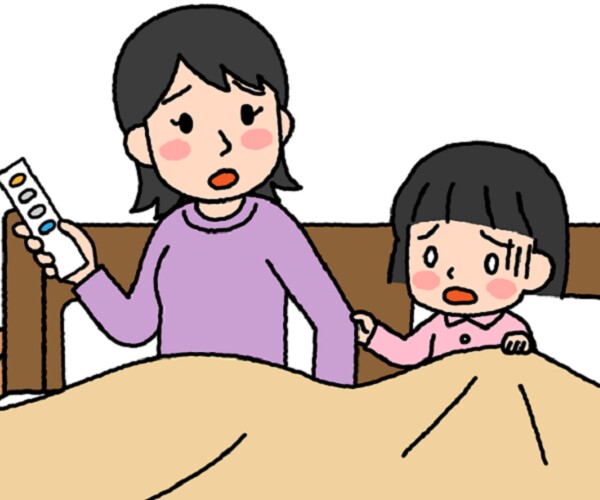Fear can take many forms for children, ranging from stranger anxiety to a fear of the dark. These fears often reflect the immaturity of their cognitive development and life experiences.
For instance, a traumatic event in the past may leave a strong impression, causing anxiety whenever a similar situation arises. Children also tend to have vivid imaginations, which can lead to frightening scenarios, such as darkness or strange sounds.

Illustrative image.
Stories, movies, or even the worries of adults can also influence a child’s emotions. When children see adults being afraid, they easily imitate and feel afraid as well.
Children who are afraid of the dark often have difficulty falling asleep, wake up easily during the night, and feel scared when their parents are not around.
Therefore, understanding the causes and impacts of these fears will help parents take appropriate supportive measures. Most importantly, creating a safe and loving environment will enable children to learn to face their fears and develop greater confidence and resilience in life.

Psychologist Quang Thi Mong Chi.

Some people suggest that when a child says, “Mom, I’m scared of the dark,” you shouldn’t rush to say that they’re brave because fear is a warning signal from the child. What is your perspective on this?
From the perspective of developmental psychology, when a child says, “Mom, I’m scared of the dark,” it is a genuine signal of their need for protection, comfort, and support from adults.
If parents or caregivers hastily respond with statements like, “Be brave, there’s nothing to be afraid of!” without acknowledging the child’s initial emotions, the child may feel denied, misunderstood, or confused about their own feelings. Over time, they may learn to repress or ignore their emotions instead of recognizing and managing them healthily.
In my opinion, when children express their fears, adults should listen and validate those feelings first. For example, a parent could say, “I see that you’re scared of the dark; the darkness can make us feel uneasy when we can’t see clearly.” Or, “You don’t feel secure when you can’t see everything, do you?” When children’s emotions are acknowledged, they feel safer to share and learn to face their fears.
After acknowledging their emotions, parents can work with their children to find suitable solutions, such as turning on a night light, exploring together to show that the darkness holds no dangers, or teaching them self-soothing techniques like deep breathing or thinking about pleasant images.

Children have vivid imaginations. How might their fear of the dark reflect other worries or experiences in their lives?
Indeed, children have very active imaginations, and their fear of the dark is often not just about “not seeing,” but also reflects deeper worries in their lives. Darkness, in a child’s mind, can become a symbol of the unknown, changes, or situations they feel are uncontrollable.
For instance, some children fear the dark because they worry about loneliness or abandonment, similar to the feeling of emptiness when they can’t see their surroundings. For children who have experienced significant changes, such as moving houses, parental separation, or even minor changes in their daily routines, the darkness may evoke feelings of insecurity and vulnerability.
Additionally, children are highly impressionable and can be influenced by stories, images, or movies with scary elements. Their imaginations can magnify these elements and directly associate them with the darkness.
Another factor is the cognitive development of children. As their imaginations flourish, children don’t just think about what is, but also imagine what “could be.” This makes scary scenarios more vivid, especially in low-light conditions like nighttime. Moreover, darkness represents a loss of control, as children can’t identify their surroundings clearly, easily triggering feelings of helplessness they may have experienced during daytime situations.
A child’s fear of the dark is not just a surface-level fear but a “gateway” for adults to explore their deeper emotional needs. Listening, supporting, and gently helping children process these worries is the best way to foster inner security and resilient emotional regulation.

Is it normal for children to be afraid of the dark? How should parents respond appropriately?
From a psychological perspective, it is entirely natural for young children to fear the dark, especially between the ages of 2 and 8, as their imaginations and understanding of the world are rapidly expanding.
Therefore, how parents respond is crucial in helping children overcome this fear healthily. First and foremost, parents should listen and validate their child’s emotions. When a child expresses fear of the dark, instead of rushing to reassure or deny their feelings, parents can gently acknowledge them: “I understand; the darkness can be unsettling when we can’t see clearly.” Validating their emotions makes children feel safer and understood.
Next, parents can work with their children to find solutions to face their fears gradually. This could involve turning on a night light, inspecting the room together before bedtime, or teaching deep breathing techniques for self-soothing.
Most importantly, parents should respect their child’s pace and not force them to “get over” their fear immediately. Patience and support are key as children gradually build a sense of control and security.
In summary, rather than trying to eliminate the fear of the dark, parents should view it as a valuable opportunity to teach children how to recognize, accept, and manage their emotions—fundamental skills for long-term psychological development.

What activities can parents do to help their children feel safer when facing the dark?
To help children feel safer when facing the dark, parents can engage in simple yet effective activities that reduce anxiety and boost feelings of control and confidence.
Firstly, establish a calming bedtime routine: reading stories, listening to soothing music, and sharing positive experiences from the day. These activities relax the nervous system and create a sense of comfort before sleep.
Using a night light with a soft glow is also a popular way to soothe fears without disrupting sleep quality.
Another effective activity is to turn experiences with darkness into games. For example, play a treasure hunt with flashlights, tell funny stories in the dark, or imagine “light friends” who protect them at night. These experiences foster positive associations with darkness instead of fear.
Parents can also teach self-soothing techniques, such as deep breathing, hugging a favorite pillow, or using a “safety charm.” When properly guided, children will gradually learn self-regulation and become less reliant on adult presence.
Lastly, the most important factor is parental presence and listening. A warm hug, kind words, or simply staying with the child for a few minutes after turning off the lights can provide immense reassurance. When children feel they aren’t facing their fears alone, their anxiety will gradually diminish.



































